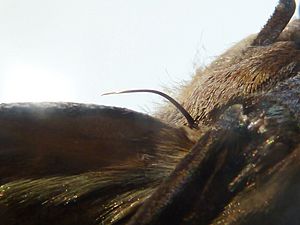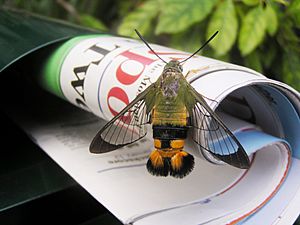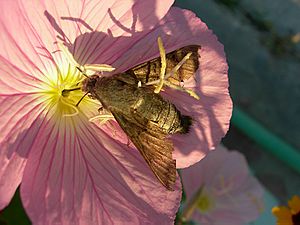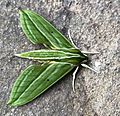Hawk moths facts for kids
Quick facts for kids Hawk moths |
|
|---|---|
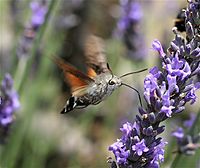 |
|
| Hummingbird hawk moth Macroglossum stellatarum |
|
| Scientific classification | |
| Kingdom: | |
| Phylum: | |
| Class: | |
| Order: | |
| Superfamily: |
Bombycoidea
|
| (unranked): | |
| Family: |
Sphingidae
|
| Type species | |
| Sphinx ligustri |
|
| Subfamilies | |
|
Macroglossinae |
|
| Diversity | |
| About 200 genera, roughly 1,200 species |
|
The Sphingidae are a family of moths, often called hawk moths, sphinx moths, or hornworms. There are about 1,450 different kinds of these moths around the world. You'll find most of them in warm, tropical places, but they live in almost every region. Hawk moths are known for being fast and strong flyers. Their narrow wings and sleek bodies help them fly quickly and for a long time. A French scientist named Pierre André Latreille gave this family its name in 1802.
Some hawk moths, like the hummingbird hawk-moth or the white-lined sphinx, can hover in the air while they sip nectar from flowers. Because of this, people sometimes mistake them for hummingbirds. This special hovering skill has only developed a few times in animals that feed on nectar. Scientists call this convergent evolution, which means different animals develop similar traits independently. Hawk moths have been studied a lot for their amazing flying skills, especially how they can quickly move side-to-side while hovering. This might help them avoid predators hiding in flowers.
Hawk moths are some of the fastest flying insects. Some can fly faster than 19 kilometers per hour (12 miles per hour). Their wings can spread from 4 to over 10 centimeters (4 inches) wide.
Description
Hawk moths usually have antennae that are not very feathery, even in males. They do not have special hearing organs called tympanal organs, but some groups, like the Choerocampini, have hearing organs on their heads. They have a special hook called a frenulum and a catch called a retinaculum to connect their front and back wings. This helps them fly more efficiently.
Their bodies and wings are covered in many tiny scales. Most hawk moths have a very long tongue-like part called a proboscis, which they use to drink nectar from flowers. Some have a very short one. Most hawk moths are active at dusk (crepuscular) or at night (nocturnal), but some species fly during the day. Both male and female hawk moths live for a relatively long time, usually 10 to 30 days. Before they fly, most species shiver their flight muscles to warm them up. During flight, their body temperature can go above 40°C (104°F).
In some species, males and females look quite different. This is called sexual dimorphism. For example, in the African Agrius convolvuli (the convolvulus hawk moth), males have thicker antennae and more mottled wing patterns than females. Only males have a special hook and catch for their wings. Also, all male hawk moths have a partial comb of hairs on their antennae. Females attract males by releasing special chemicals called pheromones. Males might also release pheromones before mating.
Behavior
Some hawk moth species fly only for short times around dusk or dawn. Other species appear later in the evening or around midnight. However, these moths can sometimes be seen feeding on flowers during the day. A few common species in Africa, like the Oriental bee hawk (Cephonodes hylas virescens), Macroglossum hirundo, and Macroglossum trochilus, are active during the day.
Flight
Scientists have studied the flight of hawk moths, especially the Manduca sexta (tobacco hornworm moth). They found that the moths' antennae help them sense how they are moving in the air. The antennae vibrate, and as the moth turns, special forces called Coriolis forces push on the antennae. These forces are detected by an organ at the base of each antenna. This helps the moth quickly control its direction and make fast turns while flying.
Life Cycle
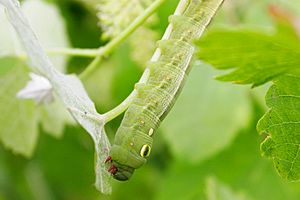
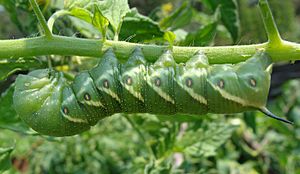
Most hawk moth species can have several generations in a year if the weather is good. Females lay eggs that are clear, greenish, flat, and smooth. They usually lay them one by one on the plants their caterpillars will eat. The time it takes for an egg to hatch can vary a lot, from three to 21 days.

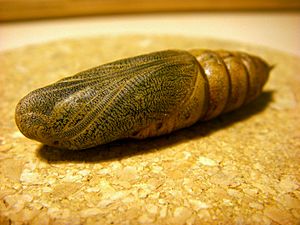
Hawk moth caterpillars are medium to large in size with thick bodies. They have five pairs of fleshy legs called prolegs. Usually, their bodies are smooth without hairs or bumps. However, most species have a "horn" at their back end. This horn might be very small or even missing in their last growth stage (called an instar). Many caterpillars are green or brown, which helps them blend in with their surroundings (this is called crypsis). They also have countershading patterns, where their underside is lighter than their top, to help them hide.
Other caterpillars have brighter colors, often with white spots on a black or yellow background. A common feature is diagonal stripes along their sides. When resting, the caterpillar often lifts its front legs and tucks its head underneath its body. This position looks a bit like the Great Sphinx of Giza, which is why they are called "sphinx moths." Some tropical caterpillars are even thought to look like snakes to scare away predators. Caterpillars can quickly spit out sticky, sometimes toxic, liquid from their stomach if attacked by ants or other small enemies.
How fast a caterpillar grows depends on the temperature. To grow faster, some species in colder areas will sunbathe. Caterpillars usually dig into the soil to turn into a pupa. They stay there for two to three weeks before they emerge as adult moths.
In some hawk moths, the pupa has a proboscis (tongue) that is not stuck to the pupal case, which is unusual for moths. They also have a special hook called a cremaster at the tip of their abdomen. Most pupate away from their food plant, either in an underground chamber, among rocks, or in a loose cocoon. For most species, the pupa is the stage where they spend the winter.
Food Plants
Larvae
Hawk moth caterpillars tend to be picky eaters. They usually eat specific types of plants rather than many different kinds. Compared to other large caterpillars, hawk moth caterpillars eat soft, young leaves that have small amounts of natural toxins. They chew their food into very tiny pieces. Some species can handle high amounts of certain toxins. For example, tobacco hornworms can get rid of nicotine very quickly. However, other species, like Hyles euphorbiae and Daphnis nerii, store toxins from their host plants in their bodies, but these toxins do not pass on to the adult moth.
Adults
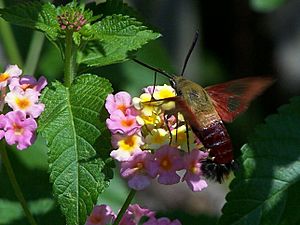
Most adult hawk moths feed on nectar from flowers. However, a few tropical species feed on eye secretions from animals, and the death's-head hawkmoths are known to steal honey from bees. Hawk moths that fly at night often prefer pale flowers with long, tube-like shapes and a sweet smell. This type of pollination is called "sphingophily." Some hawk moths visit many different kinds of flowers, while others are very specific. Sometimes, a plant can only be pollinated by one particular species of moth.
Orchids often have these very specific relationships with hawk moths and have very long nectar tubes. The comet orchid (Angraecum sesquipedale), a rare flower from Madagascar, stores its nectar at the bottom of a 30-centimeter (12-inch) long tube. In 1822, a scientist named Louis-Marie Aubert du Petit-Thouars described it. Later, Charles Darwin famously predicted that there must be a special animal with a very long tongue to reach the nectar:
[A. sesquipetale has] nectaries 11 and a half inches long, with only the lower inch and a half filled with very sweet nectar [...] it is, however, surprising, that any insect should be able to reach the nectar: our English sphinxes have probosces as long as their bodies, but in Madagascar there must be moths with probosces capable of extension to a length of between 10 and 12 inches!
Another scientist, Alfred Russel Wallace, agreed with Darwin. He even published a drawing of what this moth might look like. He added:
[The proboscis of a hawk moth] from tropical Africa ([Xanthopan] morganii) is seven inches and a half. A species having a proboscis two or three inches longer could reach the nectar in the largest flowers of Angraecum sesquipedale, whose nectaries vary in length from ten to fourteen inches. That such a moth exists in Madagascar may be safely predicted, and naturalists who visit that island should search for it with as much confidence as astronomers searched for the planet Neptune, – and they will be equally successful.
The predicted hawk moth was discovered 21 years later! It was named Xanthopan morganii praedicta, with "praedicta" meaning "the predicted one." This Madagascan moth had a pink chest and abdomen, and a black line on its front wing, which was different from the African moths. Scientists believe that the Madagascan and African hawk moths separated about 7.4 million years ago. This time period matches when the comet orchid and its close relatives developed their very long nectar tubes. This suggests that long-tongued moths like Xanthopan morganii praedicta were already around to use these long flowers.
Images for kids
-
A sphinx moth, subfamily Macroglossinae, in Cibodas Botanical Garden, Java
See also
 In Spanish: Sphingidae para niños
In Spanish: Sphingidae para niños


